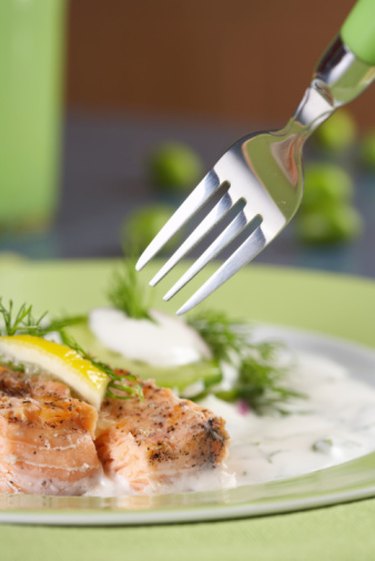
The Monterey Bay Aquarium, in Monterey, California, lists wild-caught Alaskan salmon as a "best choice" among salmon food options that support sustainable oceans. However, much of the salmon available to U.S. consumers comes from fish farms, controversial due to health and environmental concerns. Foodies may, in addition, choose wild salmon over farmed for its taste. Check the label to see where your fish comes from and know some facts about two specific salmon species: coho and sockeye.
Nutritional Benefits and Taste
Video of the Day
All salmon, particularly wild salmon, is very rich in omega-3 fatty acids which provide health benefits to the heart, joints and memory. For this reason, salmon is considered a "super food,"' which should form a regular part of the diet. Coho salmon has a high fat content, with a fine flesh. Sockeye, the most popular of the salmon species due to its rich flavor and adaptability to many cooking techniques, is high in oil with a firm flesh.
Video of the Day
Size, Lifespan and Color
An average coho is more than twice the size of an average sockeye, reaching weight upward of 15 pounds and 7 pounds, respectively. Sockeye live as long as five years while coho only live for three. Coho are bright silver. As they mature, they become reddish on the sides and green on the back and head. Male cohos are more deeply colored than females at this stage. Sockeye are a purplish-silver color and develop a bright red body, including fins, as they mature and sport a green head. Female sockeye have additional green and yellow blotches on the body as they mature.
Distinctive Physical Characteristics
Unlike coho, male sockeye develop a hump on their backs as they mature. The female does not develop a hump, nor does she develop a hooked jaw like the male sockeye does. A coho is particularly distinguished by its white gums and a few spots on the tail -- a sockeye by its prominent and glassy eyes. The sockeye is also the slimmest of all Pacific salmon species.
How to Buy and Cook
When looking to purchase both coho and sockeye, look for bright silvery skin on whole fish and a lack of jellying of the flesh. Fat in fillets should be gray and silver with no green color; fillets should also look moist. Salmon will fit with most any garnishment; cook it with acidic or creamy sauces, pan-fried, on the grill or baked.
- Monterey Bay Aquarium: Salmon -- Seafood Watch
- Bon Appetit: Ingredients -- Salmon
- WebMD: 'Superfoods' Everyone Needs
- Fisheries and Oceans Canada: Pacific Region -- Species -- Coho Salmon
- Fisheries and Oceans Canada: Pacific Region -- Species -- Sockeye Salmon
- Mayo Clinic: Healthy Recipe -- Baked salmon with Southeast Asian marinade